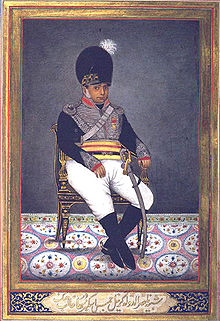James Skinner (East India Company officer)
| James Skinner | |
|---|---|

James Skinner CB (1778–1841), 19th century. Probably from Thomas Metcalfe's book dated 1843.
|
|
| Nickname(s) | Sikandar Sahib |
| Born | 1778 |
| Died | December 4, 1841 (aged 62–63) |
| Rank | Lieutenant-Colonel |
| Unit | Skinner's Horse |
Colonel James Skinner CB (1778 – 4 December 1841) was an Anglo-Indian military adventurer in India, who became known as Sikandar Sahib later in life, and is most known for two cavalry regiments he raised for the British, later known as 1st Skinner's Horse and 3rd Skinner's Horse (formerly 2nd Skinner's Horse) at Hansi in 1803, which still are a part of the Indian Army
He was a fluent writer in Persian, the court and intellectual language of India in his day, and wrote several books in Persian, including "Kitab-i tasrih al-aqvam" (History of the Origin and Distinguishing Marks of the Different Castes of India), now with the Library of Congress.
Skinner was born in 1778 in Calcutta (Kolkata) India. His father was Lieutenant-Colonel Hercules Skinner, an officer in the East India Company Army of Scottish origin, while his mother was a Rajput princess, daughter of a zamindar, she was taken prisoner at the age of fourteen, and came under the care of his father, then an ensign, who treated her with much regard, and subsequently they had seven children, two girls and five boys, Joseph, James, Hercules, Alexander, Thomas, Louisa and Elizabeth. When he was 12 years old his mother committed suicide. He was first educated at an English school in Calcutta, and then at a boarding school.
His father originally apprenticed him to a printer in Calcutta but hating the life he ran away after three days. Because of his Indian heritage, Skinner was unable to serve as an officer in the East India Company army and, at the age of sixteen, he entered the Mahratta army as an ensign under Benoît de Boigne, the French commander of Maharaja Scindia's forces of Gwalior State. Boigne was impressed by his family ancestry, Skinners having served William the Conqueror in the 11th century. Once taken in, Skinner soon showed military talent. He remained in the same service under Pierre Cuillier-Perron, who became commander-in-chief of Sindhia's army after Boigne's retirement, until 1803, when, on the outbreak of the second Anglo-Maratha War, all Anglo-Indians were dismissed from Mahratta service.
...
Wikipedia
